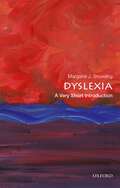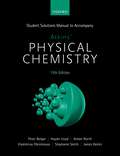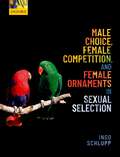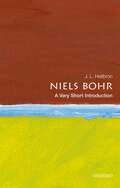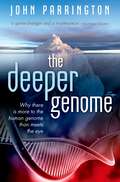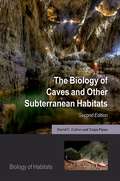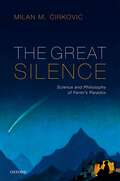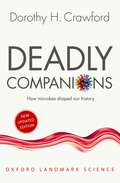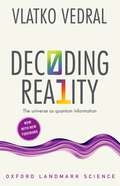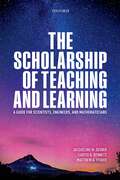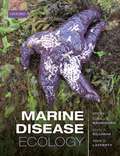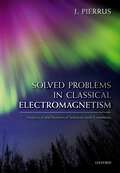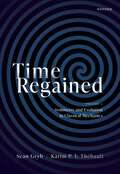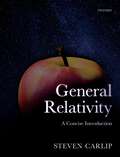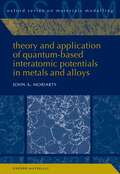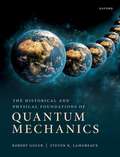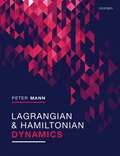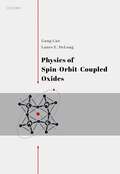- Table View
- List View
Dyslexia: A Very Short Introduction (Very Short Introductions)
by Margaret J. SnowlingSince dyslexia was first described in the British Medical Journal in 1896, there has been debate about the definitions and diagnostic procedures used, with some casting doubt on its very existence. However, there is now a considerable body of research regarding the nature and characteristics of this relatively common learning disorder. The contemporary view of dyslexia has emerged from a century of research in medicine, psychology and more recently neuroscience, and we now understand enough about this learning disorder to guide policy and practice. This Very Short Introduction provides an accessible overview of this exciting field of research, beginning with its history, and drawing on testimony from people living with dyslexia. Considering the potential causes of dyslexia, and looking at both genetic and environment factors, Margaret Snowling shows how cross-linguistic studies have documented the prevalence of dyslexia in different languages. Discussing the various brain scanning techniques that have been used to find out if the brains of people with dyslexia differ in structure or function from those of typical readers, Snowling moves on to weigh up various strategies and interventions which can help people living with dyslexia today. ABOUT THE SERIES: The Very Short Introductions series from Oxford University Press contains hundreds of titles in almost every subject area. These pocket-sized books are the perfect way to get ahead in a new subject quickly. Our expert authors combine facts, analysis, perspective, new ideas, and enthusiasm to make interesting and challenging topics highly readable.
Dyslexia: Biology, Cognition And Intervention (Very Short Introductions)
by Margaret J. SnowlingSince dyslexia was first described in the British Medical Journal in 1896, there has been debate about the definitions and diagnostic procedures used, with some casting doubt on its very existence. However, there is now a considerable body of research regarding the nature and characteristics of this relatively common learning disorder. The contemporary view of dyslexia has emerged from a century of research in medicine, psychology and more recently neuroscience, and we now understand enough about this learning disorder to guide policy and practice. This Very Short Introduction provides an accessible overview of this exciting field of research, beginning with its history, and drawing on testimony from people living with dyslexia. Considering the potential causes of dyslexia, and looking at both genetic and environment factors, Margaret Snowling shows how cross-linguistic studies have documented the prevalence of dyslexia in different languages. Discussing the various brain scanning techniques that have been used to find out if the brains of people with dyslexia differ in structure or function from those of typical readers, Snowling moves on to weigh up various strategies and interventions which can help people living with dyslexia today. ABOUT THE SERIES: The Very Short Introductions series from Oxford University Press contains hundreds of titles in almost every subject area. These pocket-sized books are the perfect way to get ahead in a new subject quickly. Our expert authors combine facts, analysis, perspective, new ideas, and enthusiasm to make interesting and challenging topics highly readable.
Student Solutions Manual to Accompany Atkins' Physical Chemistry 11th Edition
by Peter Bolgar Haydn Lloyd Aimee North Vladimiras Oleinikovas Stephanie Smith James KeelerThe Student Solutions Manual to accompany Atkins' Physical Chemistry 11th Edition provides full worked solutions to the 'a' exercises, and the odd-numbered discussion questions and problems presented in the parent book. The manual is intended for students and provides helpful comments and friendly advice to aid understanding.
Male Choice, Female Competition, and Female Ornaments in Sexual Selection
by Ingo SchluppWhen Charles Darwin first proposed Sexual Selection Theory, he suggested two mechanisms: competition among males and choice by females. Although their importance is long established and extremely well understood, their mirror images have remained largely underappreciated; males also choose, and females also compete. The combination of male mate choice (MMC) and female competition (FC) may be one of the most overlooked yet important and intriguing phenomena in modern sexual selection theory. This novel text reviews our current understanding of MMC and FC, highlighting the important connections between them. It places both concepts in the context of related fields such as female choice, mating systems, and sexual selection theory more broadly. A truly holistic approach is provided which takes all the relevant elements into consideration, especially the relative roles of MMC and FC, female ornamentation, their evolutionary consequences, and their genetic basis. Considering male mate choice and female competition in this way as effectively two sides of the same coin creates a powerful paradigm for a more complete understanding of sexual selection. Male Choice, Female Competition, and Female Ornaments in Sexual Selection will be suitable for both graduate students and researchers interested in sexual selection from an evolutionary, psychological, and anthropological perspective. It will also appeal to a broader audience of behavioural ecologists and evolutionary psychologists.
Niels Bohr: A Very Short Introduction (Very Short Introductions)
by J. L. HeilbronNiels Bohr, who pioneered the quantum theory of the atom, had a broad conception of his obligations as a physicist. They included not only a responsibility for the consequences of his work for the wider society, but also a compulsion to apply the philosophy he deduced from his physics to improving ordinary people's understanding of the moral universe they inhabit. In some of these concerns Bohr resembled Einstein, although Einstein could not accept what he called the "tranquilizing philosophy" with which Bohr tried to resolve such ancient conundrums as the nature (or possibility) of free will. In this Very Short Introduction John Heilbron draws on sources never before presented in English to cover the life and work of one of the most creative physicists of the 20th century. In addition to his role as a scientist, Heilbron considers Bohr as a statesman and Danish cultural icon, who built scientific institutions and pushed for the extension of international cooperation in science to all nation states. As a humanist he was concerned with the cultivation of all sides of the individual, and with the complementary contributions of all peoples to the sum of human culture. Throughout, Heilbron considers how all of these aspects of Bohr's personality influenced his work, as well as the science that made him, in the words of Sir Henry Dale, President of the Royal Society of London, probably the "first among all the men of all countries who are now active in any department of science." ABOUT THE SERIES: The Very Short Introductions series from Oxford University Press contains hundreds of titles in almost every subject area. These pocket-sized books are the perfect way to get ahead in a new subject quickly. Our expert authors combine facts, analysis, perspective, new ideas, and enthusiasm to make interesting and challenging topics highly readable.
Niels Bohr: A Very Short Introduction (Very Short Introductions)
by J. L. HeilbronNiels Bohr, who pioneered the quantum theory of the atom, had a broad conception of his obligations as a physicist. They included not only a responsibility for the consequences of his work for the wider society, but also a compulsion to apply the philosophy he deduced from his physics to improving ordinary people's understanding of the moral universe they inhabit. In some of these concerns Bohr resembled Einstein, although Einstein could not accept what he called the "tranquilizing philosophy" with which Bohr tried to resolve such ancient conundrums as the nature (or possibility) of free will. In this Very Short Introduction John Heilbron draws on sources never before presented in English to cover the life and work of one of the most creative physicists of the 20th century. In addition to his role as a scientist, Heilbron considers Bohr as a statesman and Danish cultural icon, who built scientific institutions and pushed for the extension of international cooperation in science to all nation states. As a humanist he was concerned with the cultivation of all sides of the individual, and with the complementary contributions of all peoples to the sum of human culture. Throughout, Heilbron considers how all of these aspects of Bohr's personality influenced his work, as well as the science that made him, in the words of Sir Henry Dale, President of the Royal Society of London, probably the "first among all the men of all countries who are now active in any department of science." ABOUT THE SERIES: The Very Short Introductions series from Oxford University Press contains hundreds of titles in almost every subject area. These pocket-sized books are the perfect way to get ahead in a new subject quickly. Our expert authors combine facts, analysis, perspective, new ideas, and enthusiasm to make interesting and challenging topics highly readable.
The Deeper Genome: Why there is more to the human genome than meets the eye
by John ParringtonOver a decade ago, as the Human Genome Project completed its mapping of the entire human genome, hopes ran high that we would rapidly be able to use our knowledge of human genes to tackle many inherited diseases, and understand what makes us unique among animals. But things didn't turn out that way. For a start, we turned out to have far fewer genes than originally thought — just over 20,000, the same sort of number as a fruit fly or worm. What's more, the proportion of DNA consisting of genes coding for proteins was a mere 2%. So, was the rest of the genome accumulated 'junk'? Things have changed since those early heady days of the Human Genome Project. But the emerging picture is if anything far more exciting. In this book, John Parrington explains the key features that are coming to light - some, such as the results of the international ENCODE programme, still much debated and controversial in their scope. He gives an outline of the deeper genome, involving layers of regulatory elements controlling and coordinating the switching on and off of genes; the impact of its 3D geometry; the discovery of a variety of new RNAs playing critical roles; the epigenetic changes influenced by the environment and life experiences that can make identical twins different and be passed on to the next generation; and the clues coming out of comparisons with the genomes of Neanderthals as well as that of chimps about the development of our species. We are learning more about ourselves, and about the genetic aspects of many diseases. But in its complexity, flexibility, and ability to respond to environmental cues, the human genome is proving to be far more subtle than we ever imagined.
The Deeper Genome: Why there is more to the human genome than meets the eye
by John ParringtonOver a decade ago, as the Human Genome Project completed its mapping of the entire human genome, hopes ran high that we would rapidly be able to use our knowledge of human genes to tackle many inherited diseases, and understand what makes us unique among animals. But things didn't turn out that way. For a start, we turned out to have far fewer genes than originally thought — just over 20,000, the same sort of number as a fruit fly or worm. What's more, the proportion of DNA consisting of genes coding for proteins was a mere 2%. So, was the rest of the genome accumulated 'junk'? Things have changed since those early heady days of the Human Genome Project. But the emerging picture is if anything far more exciting. In this book, John Parrington explains the key features that are coming to light - some, such as the results of the international ENCODE programme, still much debated and controversial in their scope. He gives an outline of the deeper genome, involving layers of regulatory elements controlling and coordinating the switching on and off of genes; the impact of its 3D geometry; the discovery of a variety of new RNAs playing critical roles; the epigenetic changes influenced by the environment and life experiences that can make identical twins different and be passed on to the next generation; and the clues coming out of comparisons with the genomes of Neanderthals as well as that of chimps about the development of our species. We are learning more about ourselves, and about the genetic aspects of many diseases. But in its complexity, flexibility, and ability to respond to environmental cues, the human genome is proving to be far more subtle than we ever imagined.
The Biology of Caves and Other Subterranean Habitats (Biology of Habitats Series)
by David C. Culver Tanja PipanThe second edition of this widely cited textbook continues to provide a concise but comprehensive introduction to cave and subterranean biology, describing this fascinating habitat and its biodiversity. It covers a range of biological processes including ecosystem function, evolution and adaptation, community ecology, biogeography, and conservation. The authors draw on a global range of examples and case studies from both caves and non-cave subterranean habitats. One of the barriers to the study of subterranean biology has been the extraordinarily large number of specialized terms used by researchers; the authors explain these terms clearly and minimize the number that they use. This new edition retains the same 10 chapter structure of the original, but the content has been thoroughly revised and updated throughout to reflect the huge increase in publications concerning subterranean biology over the last decade.
The Great Silence: Science and Philosophy of Fermi's Paradox
by Milan M. ĆirkovićThe Great Silence explores the multifaceted problem named after the great Italian physicist Enrico Fermi and his legendary 1950 lunchtime question "Where is everybody?" In many respects, Fermi's paradox is the richest and the most challenging problem for the entire field of astrobiology and the Search for ExtraTerrestrial Intelligence (SETI) studies. This book shows how Fermi's paradox is intricately connected with many fields of learning, technology, arts, and even everyday life. It aims to establish the strongest possible version of the problem, to dispel many related confusions, obfuscations, and prejudices, as well as to offer a novel point of entry to the many solutions proposed in existing literature. Milan Cirkovic argues that any evolutionary worldview cannot avoid resolving the Great Silence problem in one guise or another.
The Great Silence: Science and Philosophy of Fermi's Paradox
by Milan M. ĆirkovićThe Great Silence explores the multifaceted problem named after the great Italian physicist Enrico Fermi and his legendary 1950 lunchtime question "Where is everybody?" In many respects, Fermi's paradox is the richest and the most challenging problem for the entire field of astrobiology and the Search for ExtraTerrestrial Intelligence (SETI) studies. This book shows how Fermi's paradox is intricately connected with many fields of learning, technology, arts, and even everyday life. It aims to establish the strongest possible version of the problem, to dispel many related confusions, obfuscations, and prejudices, as well as to offer a novel point of entry to the many solutions proposed in existing literature. Milan Cirkovic argues that any evolutionary worldview cannot avoid resolving the Great Silence problem in one guise or another.
Deadly Companions: How Microbes Shaped our History (Oxford Landmark Science)
by Dorothy H. CrawfordEver since we started huddling together in communities, the story of human history has been inextricably entwined with the story of microbes. They have evolved and spread amongst us, shaping our culture through infection, disease, and pandemic. At the same time, our changing human culture has itself influenced the evolutionary path of microbes. Dorothy H. Crawford here shows that one cannot be truly understood without the other. Beginning with a dramatic account of the SARS pandemic at the start of the 21st century, she takes us back in time to follow the interlinked history of microbes and man, taking an up-to-date look at ancient plagues and epidemics, and identifying key changes in the way humans have lived - such as our move from hunter-gatherer to farmer to city-dweller — which made us vulnerable to microbe attack. Showing how we live our lives today — with increasing crowding and air travel — puts us once again at risk, Crawford asks whether we might ever conquer microbes completely, or whether we need to take a more microbe-centric view of the world. Among the possible answers, one thing becomes clear: that for generations to come, our deadly companions will continue to shape human history. Oxford Landmark Science books are 'must-read' classics of modern science writing which have crystallized big ideas, and shaped the way we think.
Deadly Companions: How Microbes Shaped our History (Oxford Landmark Science)
by Dorothy H. CrawfordEver since we started huddling together in communities, the story of human history has been inextricably entwined with the story of microbes. They have evolved and spread amongst us, shaping our culture through infection, disease, and pandemic. At the same time, our changing human culture has itself influenced the evolutionary path of microbes. Dorothy H. Crawford here shows that one cannot be truly understood without the other. Beginning with a dramatic account of the SARS pandemic at the start of the 21st century, she takes us back in time to follow the interlinked history of microbes and man, taking an up-to-date look at ancient plagues and epidemics, and identifying key changes in the way humans have lived - such as our move from hunter-gatherer to farmer to city-dweller — which made us vulnerable to microbe attack. Showing how we live our lives today — with increasing crowding and air travel — puts us once again at risk, Crawford asks whether we might ever conquer microbes completely, or whether we need to take a more microbe-centric view of the world. Among the possible answers, one thing becomes clear: that for generations to come, our deadly companions will continue to shape human history. Oxford Landmark Science books are 'must-read' classics of modern science writing which have crystallized big ideas, and shaped the way we think.
Decoding Reality: The Universe as Quantum Information (Oxford Landmark Science)
by Vlatko VedralFor a physicist, all the world is information. The Universe and its workings are the ebb and flow of information. We are all transient patterns of information, passing on the recipe for our basic forms to future generations using a four-letter digital code called DNA. In this engaging and mind-stretching account, Vlatko Vedral considers some of the deepest questions about the Universe and considers the implications of interpreting it in terms of information. He explains the nature of information, the idea of entropy, and the roots of this thinking in thermodynamics. He describes the bizarre effects of quantum behaviour — effects such as 'entanglement', which Einstein called 'spooky action at a distance', and explores cutting edge work on harnessing quantum effects in hyperfast quantum computers, and how recent evidence suggests that the weirdness of the quantum world, once thought limited to the tiniest scales, may reach into the macro world. Vedral finishes by considering the answer to the ultimate question: where did all of the information in the Universe come from? The answers he considers are exhilarating, drawing upon the work of distinguished physicist John Wheeler. The ideas challenge our concept of the nature of particles, of time, of determinism, and of reality itself. This edition includes a new foreword from the author, reflecting on changes in the world of quantum information since first publication. Oxford Landmark Science books are 'must-read' classics of modern science writing which have crystallized big ideas, and shaped the way we think.
Decoding Reality: The Universe as Quantum Information (Oxford Landmark Science)
by Vlatko VedralFor a physicist, all the world is information. The Universe and its workings are the ebb and flow of information. We are all transient patterns of information, passing on the recipe for our basic forms to future generations using a four-letter digital code called DNA. In this engaging and mind-stretching account, Vlatko Vedral considers some of the deepest questions about the Universe and considers the implications of interpreting it in terms of information. He explains the nature of information, the idea of entropy, and the roots of this thinking in thermodynamics. He describes the bizarre effects of quantum behaviour — effects such as 'entanglement', which Einstein called 'spooky action at a distance', and explores cutting edge work on harnessing quantum effects in hyperfast quantum computers, and how recent evidence suggests that the weirdness of the quantum world, once thought limited to the tiniest scales, may reach into the macro world. Vedral finishes by considering the answer to the ultimate question: where did all of the information in the Universe come from? The answers he considers are exhilarating, drawing upon the work of distinguished physicist John Wheeler. The ideas challenge our concept of the nature of particles, of time, of determinism, and of reality itself. This edition includes a new foreword from the author, reflecting on changes in the world of quantum information since first publication. Oxford Landmark Science books are 'must-read' classics of modern science writing which have crystallized big ideas, and shaped the way we think.
The Scholarship of Teaching and Learning: A Guide for Scientists, Engineers, and Mathematicians
by Jacqueline Dewar Curtis Bennett Matthew A. FisherThe Scholarship of Teaching and Learning: A Guide for Scientists, Engineers, and Mathematicians shows college and university faculty members how to draw on their disciplinary knowledge and teaching experience to investigate questions about student learning. It takes readers all the way through the inquiry process beginning with framing a research question and selecting a research design, moving on to gathering and analyzing evidence, and finally to making the results public. Numerous examples are provided at each stage, many from published studies of teaching and learning in science, engineering, or mathematics. At strategic points, short sets of questions prompt readers to pause and reflect, plan, or act. These questions are derived from the authors' experience leading many workshops in the United States and Canada on how to do the scholarship of teaching and learning (SoTL). The taxonomy of SoTL questions-What works? What is? What could be?-that emerged from the SoTL studies undertaken by scholars in the Carnegie Academic for the Scholarship of Teaching and Learning serves as a framework at many stages of the inquiry process. The book addresses the issue of evaluating and valuing this work, including implications for junior faculty who wish to engage in SoTL. The authors explain why SoTL should be of interest to STEM (science, technology, engineering, and mathematics) faculty at all types of higher education institutions, including faculty members active in traditional STEM research. They also give their perspective on the benefits of SoTL to faculty, to their institutions, to the academy, and to students.
The Scholarship of Teaching and Learning: A Guide for Scientists, Engineers, and Mathematicians (Scholarship Of Teaching And Learning Ser.)
by Curtis Bennett Jacqueline Dewar Matthew A. FisherThe Scholarship of Teaching and Learning: A Guide for Scientists, Engineers, and Mathematicians shows college and university faculty members how to draw on their disciplinary knowledge and teaching experience to investigate questions about student learning. It takes readers all the way through the inquiry process beginning with framing a research question and selecting a research design, moving on to gathering and analyzing evidence, and finally to making the results public. Numerous examples are provided at each stage, many from published studies of teaching and learning in science, engineering, or mathematics. At strategic points, short sets of questions prompt readers to pause and reflect, plan, or act. These questions are derived from the authors' experience leading many workshops in the United States and Canada on how to do the scholarship of teaching and learning (SoTL). The taxonomy of SoTL questions-What works? What is? What could be?-that emerged from the SoTL studies undertaken by scholars in the Carnegie Academic for the Scholarship of Teaching and Learning serves as a framework at many stages of the inquiry process. The book addresses the issue of evaluating and valuing this work, including implications for junior faculty who wish to engage in SoTL. The authors explain why SoTL should be of interest to STEM (science, technology, engineering, and mathematics) faculty at all types of higher education institutions, including faculty members active in traditional STEM research. They also give their perspective on the benefits of SoTL to faculty, to their institutions, to the academy, and to students.
Marine Disease Ecology
Whether through loss of habitat or cascading community effects, diseases can shape the very nature of the marine environment. Despite their significant impacts, studies of marine diseases have tended to lag behind their terrestrial equivalents, particularly with regards to their ecological effects. However, in recent decades global research focused on marine disease ecology has expanded at an accelerating rate. This is due in part to increases in disease emergence across many taxa, but can also be attributed to a broader realization that the parasites responsible for disease are themselves important members of marine communities. Understanding their ecological relationships with the environment and their hosts is critical to understanding, conserving, and managing natural and exploited populations, communities, and ecosystems. Courses on marine disease ecology are now starting to emerge and this first textbook in the field will be ideally placed to serve them. Marine Disease Ecology is suitable for graduate students and researchers in the fields of marine disease ecology, aquaculture, fisheries, veterinary science, evolution and conservation. It will also be of relevance and use to a broader interdisciplinary audience of government agencies, NGOs, and marine resource managers.
Solved Problems in Classical Electromagnetism: Analytical and Numerical Solutions with Comments
by J. PierrusClassical electromagnetism - one of the fundamental pillars of physics - is an important topic for all types of physicists from the theoretical to the applied. The subject is widely recognized to be one of the most challenging areas of the physics curriculum, both for students to learn and for lecturers to teach. Although textbooks on electromagnetism are plentiful, hardly any are written in the question-and-answer style format adopted in this book. It contains nearly 300 worked questions and solutions in classical electromagnetism, and is based on material usually encountered during the course of a standard university physics degree. Topics covered include some of the background mathematical techniques, electrostatics, magnetostatics, elementary circuit theory, electrodynamics, electromagnetic waves and electromagnetic radiation. For the most part the book deals with the microscopic theory, although we also introduce the important subject of macroscopic electromagnetism as well. Nearly all questions end with a series of comments whose purpose is to stimulate inductive reasoning and reach various important conclusions arising from the problem. Occasionally, points of historical interest are also mentioned. Both analytical and numerical techniques are used in obtaining and analyzing solutions. All computer calculations are performed with MathematicaCO® and the relevant code is provided in a notebook; either in the solution or the comments.
Time Regained: Volume 1: Symmetry and Evolution in Classical Mechanics
by Sean Gryb Karim ThébaultThis book focuses on one of the oldest and most fundamental questions in both physics and philosophy: the nature of time. It presents original theoretical physics research on the 'problem of time' in modern physics, in parallel with a new philosophical framework for the analysis of symmetry and evolution in physical theory, as well as new work on the early modern precursors to the problem of time. Contrary to the standard wisdom, this book argues that a substantive notion of time can, and should, be retained within a consistent formalism for modern physical theory. The book marshals an array of philosophical and formal tools to justify this claim and analyses its physical implications. This book is the first of a two-volume project articulating a new approach to the analysis of time in modern physical theory. The second volume will extend and apply this approach in the context of classical and quantum gravity including quantum cosmological models.
General Relativity: A Concise Introduction
by Steven CarlipEinstein's general theory of relativity — currently our best theory of gravity — is important not only to specialists, but to a much wider group of physicists. This short textbook on general relativity and gravitation offers students glimpses of the vast landscape of science connected to general relativity. It incorporates some of the latest research in the field. The book is aimed at readers with a broad range of interests in physics, from cosmology, to gravitational radiation, to high energy physics, to condensed matter theory. The pedagogical approach is "physics first": readers move very quickly to the calculation of observational predictions, and only return to the mathematical foundations after the physics is established. In addition to the "standard" topics covered by most introductory textbooks, it contains short introductions to more advanced topics: for instance, why field equations are second order, how to treat gravitational energy, and what is required for a Hamiltonian formulation of general relativity. A concluding chapter discusses directions for further study, from mathematical relativity, to experimental tests, to quantum gravity. This is an introductory text, but it has also been written as a jumping-off point for readers who plan to study more specialized topics.
Theory and Application of Quantum-Based Interatomic Potentials in Metals and Alloys (Oxford Series on Materials Modelling #8)
by Dr John A. MoriartyAtomistic computer simulations are often at the heart of modern attempts to predict and understand the physical properties of real materials, including the vast domain of metals and alloys. Historically, highly simplified empirical potentials have been used to provide the interatomic forces needed to perform such simulations, but true predictive power in these materials emanates from fundamental quantum mechanics. In metals and alloys especially, a viable path forward to the vastly larger length and time scales offered by empirical potentials, while retaining the predictive power of quantum mechanics, is to course-grain the underlying electronic structure of the material and systematically derive quantum-based interatomic potentials from first-principles. This book spans the entire process from foundation in fundamental theory, to the development of accurate quantum-based potentials for real materials, to the wide-spread application of the potentials to the atomistic simulation of structural, thermodynamic, defect and mechanical properties of metals and alloys.
The Historical and Physical Foundations of Quantum Mechanics
by Robert Golub Steve LamoreauxFollowing the path by which humanity learned quantum mechanics can lead to an improved teaching and understanding of the fundamental theory and the origins of its perceived limitations. The purpose of this textbook is to retrace the development of quantum mechanics by investigating primary sources (including original published papers and letters) with attention to their timing and influence. Placing the development of quantum mechanics in its historical context, from the nascent philosophical notions of matter, atoms, and void in Ancient Greece, to their scientific realization in the 19th and 20th centuries, the book culminates with an examination of the current state of the field and an introduction to quantum information and computing.
Lagrangian and Hamiltonian Dynamics
by Peter MannAn introductory textbook exploring the subject of Lagrangian and Hamiltonian dynamics, with a relaxed and self-contained setting. Lagrangian and Hamiltonian dynamics is the continuation of Newton's classical physics into new formalisms, each highlighting novel aspects of mechanics that gradually build in complexity to form the basis for almost all of theoretical physics. Lagrangian and Hamiltonian dynamics also acts as a gateway to more abstract concepts routed in differential geometry and field theories and can be used to introduce these subject areas to newcomers. Journeying in a self-contained manner from the very basics, through the fundamentals and onwards to the cutting edge of the subject, along the way the reader is supported by all the necessary background mathematics, fully worked examples, thoughtful and vibrant illustrations as well as an informal narrative and numerous fresh, modern and inter-disciplinary applications. The book contains some unusual topics for a classical mechanics textbook. Most notable examples include the 'classical wavefunction', Koopman-von Neumann theory, classical density functional theories, the 'vakonomic' variational principle for non-holonomic constraints, the Gibbs-Appell equations, classical path integrals, Nambu brackets and the full framing of mechanics in the language of differential geometry.
Physics of Spin-Orbit-Coupled Oxides
by Gang Cao Lance DeLongThis book is aimed at graduate students, post docs and senior researchers with preliminary expertise in materials physics or chemistry, and with an interest in the physical and chemical properties of 4d- and 5d transition metal oxides, especially ruthenates and iridates. The 4d- and 5d-transition metal oxides are among the most current and interesting quantum materials. This book reviews recent experimental and theoretical evidence that the physical and structural properties of these materials are decisively influenced by strong spin-orbit interactions that compete with comparable Coulomb, magnetic exchange and crystalline electric field interactions. This competition often leads to unusual ground states and magnetic frustration that are unique to this class of materials. Novel coupling between the orbital/lattice and spin degrees of freedom, which seriously challenge current theoretical models and are not addressed by traditional textbooks, are of particular interest, This book also reviews a few techniques for single-crystal growth that are most suitable for the 4d- and 5d-transition metal oxides. The discussion is intended to help fill an existing void in the literature describing relevant synthesis techniques for 4d- and 5d-materials, which is a daunting experimental challenge.
